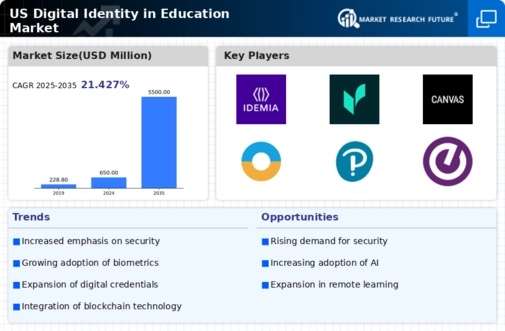Emphasis on User-Centric Design
The digital identity-in-education market is increasingly focusing on user-centric design principles. Educational institutions are recognizing the importance of creating intuitive and accessible identity management systems that enhance user experience for students and faculty alike. This shift towards user-centric design is expected to drive market growth, as institutions aim to improve engagement and satisfaction among users. In 2025, it is estimated that user-friendly identity solutions will account for over 40% of the digital identity-in-education market. By prioritizing usability, educational institutions can foster a more secure and efficient environment for managing digital identities, ultimately contributing to the overall success of the digital identity-in-education market.
Regulatory Compliance and Standards
The digital identity-in-education market is significantly influenced by the increasing emphasis on regulatory compliance and standards. Educational institutions are required to adhere to various regulations that govern data protection and privacy, such as the Family Educational Rights and Privacy Act (FERPA) in the US. As compliance becomes more stringent, institutions are compelled to invest in digital identity solutions that ensure adherence to these regulations. This has resulted in a projected market growth of approximately 15% by 2026, as institutions seek to mitigate risks associated with non-compliance. The digital identity-in-education market is thus positioned to benefit from the heightened focus on regulatory frameworks, driving innovation and investment in secure identity management solutions.
Rise of Remote Learning Environments
The digital identity-in-education market is witnessing a transformation due to the rise of remote learning environments. As educational institutions increasingly adopt online platforms, the need for robust digital identity solutions becomes paramount. In 2025, it is anticipated that the market for digital identity solutions tailored for remote learning will exceed $2 billion, reflecting a growing recognition of the importance of secure access to educational resources. This shift necessitates the implementation of identity management systems that can effectively authenticate users and protect sensitive data. Consequently, the digital identity-in-education market is likely to expand, driven by the demand for solutions that facilitate secure and seamless online learning experiences.
Growing Demand for Secure Authentication
The digital identity-in-education market is experiencing a notable surge in demand for secure authentication methods. Educational institutions are increasingly prioritizing the protection of student data, which has led to the adoption of advanced identity verification technologies. In 2025, it is estimated that the market for identity verification solutions in education will reach approximately $1.5 billion, reflecting a growth rate of around 20% annually. This trend is driven by the need to prevent unauthorized access to sensitive information and ensure compliance with regulations such as FERPA. As institutions seek to enhance their security measures, the digital identity-in-education market is likely to expand, offering innovative solutions that cater to the evolving needs of educational stakeholders.
Increased Investment in EdTech Solutions
The digital identity-in-education market is benefiting from increased investment in educational technology (EdTech) solutions. As schools and universities allocate more resources towards technology integration, the demand for secure digital identity management systems is expected to rise. In 2025, EdTech investments in the US are projected to reach $30 billion, with a significant portion directed towards enhancing digital security measures. This trend indicates a growing recognition of the importance of safeguarding student identities and data. As educational institutions seek to leverage technology for improved learning outcomes, the digital identity-in-education market is likely to see substantial growth, driven by the need for innovative identity solutions that align with EdTech advancements.

















Leave a Comment